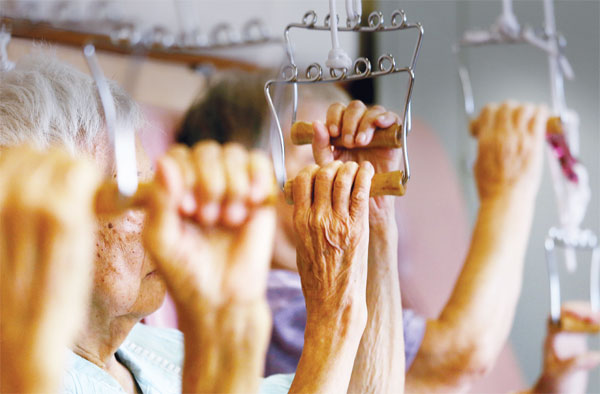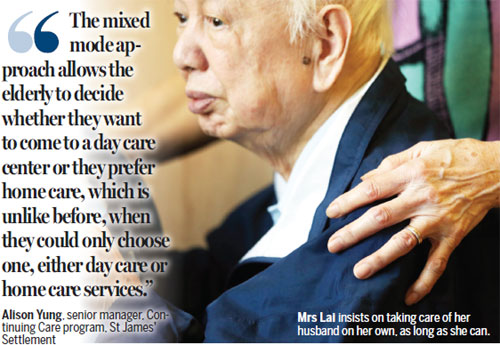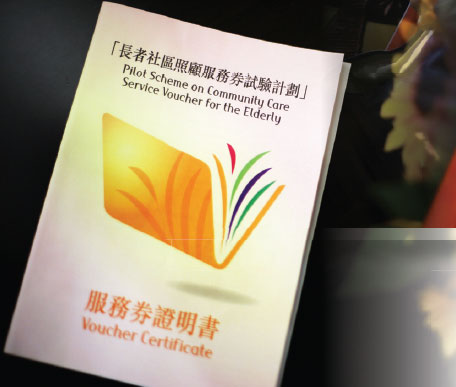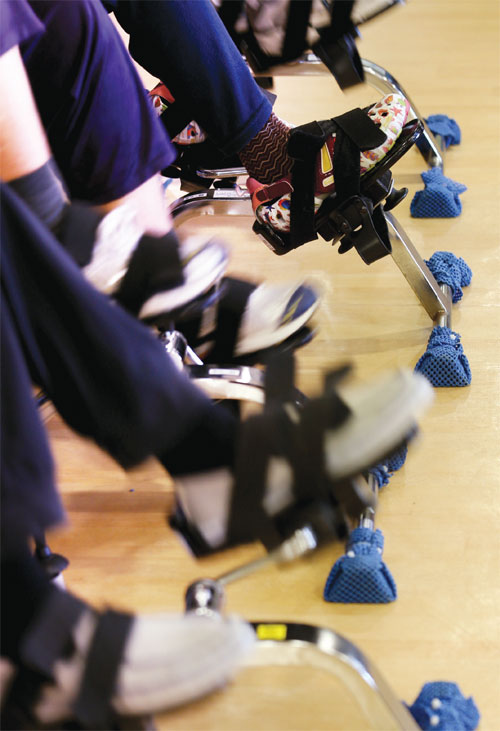The age of choice
Updated: 2015-07-14 10:01
By Ming Yeung(HK Edition)
|
|||||||||
In 2013 the HKSAR Government introduced a novel scheme enabling citizens to pick a care service for their old age. Ming Yeung investigates what made some of those who signed up for the program drop out.
Ever since Mr Lai was hit by dementia, his wife of over 50 years has never let him out of sight.
"I used to go out for morning exercise every day. One day when I came home at 7 am, I saw him naked, having a shower. The water was freezing cold," recalled Mrs Lai.
Since that incident she is scared to leave him alone. She does the grocery shopping when their son visits them every few days.
Taking an 85-year-old man out for a short walk on a wheelchair could be a chore for his wife, now 77, but Mrs Lai is keen to do it herself, as long as she can. "The only thing I fear is when I get sick I will no longer be able to care for him."
In June last year, Mr Lai was introduced to a brand new community service scheme for the elderly. Earlier he was going to a community center for dementia patients run by St James' Settlement (SJS).
To each his own
The Social Welfare Department (SWD) introduced the first phase of the four-year Pilot Scheme on the Community Care Service Voucher for the Elderly in September 2013. The project is offered in eight select districts in Hong Kong and a maximum of 1,200 vouchers will be issued. The scheme is aimed at testing the "money-follows-the-user" funding mode, to allow greater flexibility to the elderly in choosing the services they want.
A total of 62 eligible, recognized service providers to be operated by 29 NGOs and two social enterprises were selected for the first phase.
Eligible participants are elderly people, who according to the results of SWD's standardized need assessment, are likely to suffer moderate impairment, while they wait to be covered by subsidized community care, including facilities offered at one's residence and long-term programs.
Each voucher is valued at HK$6,000. A sliding scale of co-payment is established for users based on a means test of household income.
The co-payment arrangement is "in line with the Elderly Commission's recommendation so that the less the user could afford, the more the government would pay".
The Elderly Commission completed a study in Community Care Services in July 2011, with the recommendation that the government launch a four-year pilot project in two phases starting 2013-14.
Traditional community care services are offered in keeping with the requirements in different districts and levels of needs, and outsourced to NGOs. Eligible users pay only a few hundred dollars a month.
Mrs Lai now sends her husband to the elderly center three days a week for occupational therapy, which leaves her with more time to do her own thing. "When I drop him off, I can go shopping without worries, knowing that the staff here will take good care of him," she says.
She is happy that her husband can now receive regular exercise and cognitive training which helps slow down the deterioration of his condition.
A mixed mode approach
Media reports indicate that 2,185 elderly people had joined the scheme. Only 1,000 remain. Lawmaker Frederick Cheung Chui-hong argues people quit because the services do not meet their needs or the co-payments are unaffordable.
SJS's E Home Plus, an elderly community care center in Shau Kei Wan, now has 33 participants. Alison Yung, senior manager of SJS's Continuing Care, said over the last two years about eight participants quit the scheme, preferring to shift to private or public elderly homes or a subvented day care center. Some of them died.
Yung said the scheme gave the needy people among the elderly, waiting for placement in various care services, another option. "The mixed mode approach allows the elderly to decide whether they want to come to a day care center or prefer home care, which is unlike before, when they could only choose one, either day care or home care services," Yung said.
"The additional 62 service providers shorten the queue of seniors who need community care services from 9-12 months to 4-5 months," she added.
Tong Choi-ying, program director (elderly care) of Christian Family Service Centre (Kwun Tong), agrees. She said certain elderly people with a moderate impairment do want to stay at home rather than live in an elderly home, so this scheme fulfills their exercise needs as well as a wish to stay with family.
But for those without a caretaker at home, the scheme is not suitable, Tong stressed. Depending on how fit they are and the living environment, some old people can opt only for home services.
If the listed NGOs admit only a handful of participants, they may not allocate extra resources for these elders or may get clubbed with other people who receive different services, Tong added.
Despite more flexibility, many grassroots elderly cannot afford to pay up HK$500-HK$2,500. So they refuse to join the scheme, explained Ivy Dai, SJS's project manager at E Home Plus.
Ideally, this mixed mode approach of combining day care center and home care services can be broadened to allow the elderly to decide to join different services operated by different organizations, like the "cash and counseling" programs implemented in Western countries, said associate professor Ernest Chui Wing-tak at the Department of Social Work and Social Administration, University of Hong Kong.
Cash and counseling give people with disabilities, including older adults, the option to manage a flexible budget and decide what mix of goods and services best meet their personal care needs.
Chui, who conducted the study on Community Care Services and whose brainchild the pilot scheme was, said the success of cash and counseling mode depended on the expertise of counselors, or case managers, in monitoring the quality of service providers.
"Money-follows-the-user" is a new funding mode where consumers influence the behavior and quality of service providers through their purchasing power. It is to be hoped, this will eliminate the poor service providers in the end, noted Tong Choi-ying.
The chronic shortage of subsidized care home spaces led to more than 5,000 elderly people die waitlisted last year alone. The government is also placing considerable emphasis on the "aging at home" approach. Ivy Dai feels that the government should allocate similar subsidies to daycare community centers. At present, a placement at a nursing home costs more than HK$14,000 whereas only a bit over HK$6,000 at a community center.
The vast difference in costs makes it difficult to recruit enough staff and upgrade services in community centers.
Invest in community care
Professor Chui explained that currently government funding for elderly services was largely spent on nursing homes whereas community-based services received only 30 percent of funding.
"Such a scenario is unreasonable as more elderly live in the community than in elderly homes. So the government would be on the right track by pouring more resources in the community," Chui said, adding that at the same time, funding for nursing homes will also keep up.
For profit-making organizations, which are expected to join the second phase of the scheme, their service quality will be questioned, given they don't have much room for resource allocation like the NGOs.
An accreditation system and random checks should be applied to all service providers to guarantee quality, Chui suggested. Users' groups with participation of family members are useful to report irregularities.
Given both the aging population in Hong Kong and the living expenses keep growing, Chui argues that the amount of money people can save for their retirement years is as important a factor as the government-allocated funds.
"If an old person has disposable money, he can freely choose whatever service he desires," Chui said. A perfect universal retirement plan would be based on personal savings, government subsidy and long-term care insurance - an idea which the stakeholders in Hong Kong are yet to agree on. "We need to strike a balance between spending too much and too little, between individual and collective responsibility," Chui said.
Tong Choi-ying advises that the second phase of the scheme includes funding for procuring extra facilities and transportation for the needy elderly who come to the community center.
Many items on the procurement list, Tong complained, are no longer usable.
"For instance, cassette tapes are still on the list although no one uses these today. We want to purchase iPads for the elderly instead to help them do a certain exercise," Tong said.
Furthermore, Dai hopes the government can improve transparency and promote more about the scheme so that the elderly can be well-informed before they make a decision. "We know the scheme aims to give the elderly more choices. But for those who do not have updated information, we should make sure they are notified by responsible social workers," she said.
In order to create a caring community, Chui reckons, more volunteer caretakers willing to participate informally in caring for the elderly in the neighborhood could be trained to help elderly people to get on in their daily lives. In return it would be nice to offer them a token of appreciation.
However, proper insurance coverage and relaxation of legislation are the two vital areas to look into to attract more participants to such an ambitious scheme.
Contact the writer at mingyeung@chinadailyhk.com

|
Mrs Lai is happy that her husband can now receive regular exercise and cognitive training to prevent his dementia from getting worse. Roy Liu / China Daily |
|
Elderly people waiting for placement in various care services could try using a community care service voucher for a different option. |
|
A community care service voucher, by testing the "money-follows-the-user" funding mode, allows greater flexibility to the elderly to choose the kind of service they want. |

(HK Edition 07/14/2015 page8)


